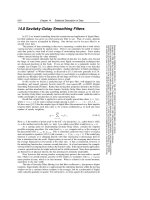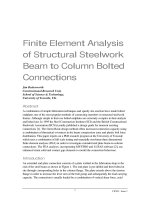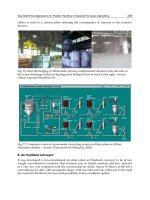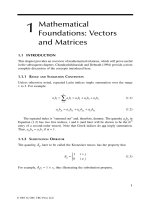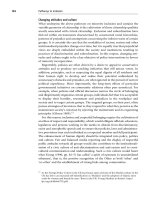Finite Element Analysis - Thermomechanics of Solids Part 9 pptx
Bạn đang xem bản rút gọn của tài liệu. Xem và tải ngay bản đầy đủ của tài liệu tại đây (1.01 MB, 18 trang )
121
Element Fields in Linear
Problems
This chapter presents interpolation models in physical coordinates for the most part,
for the sake of simplicity and brevity. However, in finite-element codes, the physical
coordinates are replaced by natural coordinates using relations similar to interpola-
tion models. Natural coordinates allow use of Gaussian quadrature for integration
and, to some extent, reduce the sensitivity of the elements to geometric details in
the physical mesh. Several examples of the use of natural coordinates are given.
9.1 INTERPOLATION MODELS
9.1.1 O
NE
-D
IMENSIONAL
M
EMBERS
9.1.1.1 Rods
The governing equation for the displacements in rods (also bars, tendons, and
shafts) is
(9.1)
in which
u
(
x
,
t
) denotes the radial displacement, E,
Α
and
ρ
are constants,
x
is the
spatial coordinate, and
t
denotes time. Since the displacement is governed by a
second-order differential equation, in the spatial domain, it requires two (time-
dependent) constants of integration. Applied to an element, the two constants can
be supplied implicitly using two nodal displacements as functions of time. We now
approximate
u
(
x
,
t
) using its values at
x
e
and
x
e
+
1
, as shown in Figure 9.1.
The lowest-order interpolation model consistent with two integration constants
is linear, in the form
(9.2)
We seek to identify ΦΦ
ΦΦ
m1
in terms of the nodal values of
u
. Letting
u
e
=
u
(
x
e
) and
u
e
+
1
=
u
(
x
e
+
1
), furnishes
(9.3)
9
EA
u
x
A
u
t
∂
∂
=
∂
∂
2
2
2
2
ρ
,
ux t x t t
ut
ut
xx
m
T
mm m
e
e
m
T
(,) () (), ()
()
()
() ( ).==
=
+
ϕϕΦΦγγ γγ ϕϕ
111 1
1
1
1,
ut x t u t x t
e e mm e e mm
() ( ) (), () ().==
()
++
11
11 1 1 11
ΦΦγγ ΦΦγγ
0749_Frame_C09 Page 121 Wednesday, February 19, 2003 5:09 PM
© 2003 by CRC CRC Press LLC
122
Finite Element Analysis: Thermomechanics of Solids
However, from the meaning of γγ
γγ
m
1
(
t
), we conclude that
(9.4)
9.1.1.2 Beams
The equation for a beam, following Euler-Bernoulli theory, is:
(9.5)
in which
w
(
x
,
t
) denotes the transverse displacement of the beam’s neutral axis, and
I
is a constant. In the spatial domain, there are four constants of integration. In an
element, they can be supplied implicitly by the values of
w
and
w
′
=
∂
w
/∂
x
at each
of the two element nodes. Referring to Figure 9.2, we introduce the interpolation
model for
w
(
x
,
t
):
(9.6)
FIGURE 9.1
Rod element.
FIGURE 9.2
Beam element.
u
e
x
e
x
e
+1
u
e
+1
x
w
e
t
w
e
w
e
t
+1
w
e+1
x
e
x
e+1
x
ΦΦ
m
e
e
e
ee
ee e
x
x
l
xx
lx x
1
1
1
1
1
1
1
1
11
=
=
−
−
=−
+
−
+
+
,.
EI
w
x
A
u
t
∂
∂
+
∂
∂
=
4
4
2
2
0
ρ
,
wx t x t x x x x t
w
w
w
w
bbb b
m
e
e
e
e
(,) () (), () , () .==
()
=
−
′
−
′
+
+
ϕϕΦΦγγϕϕγγ
ΤΤΤΤ
111 1
23
1
1
1
1
0749_Frame_C09 Page 122 Wednesday, February 19, 2003 5:09 PM
© 2003 by CRC CRC Press LLC
Element Fields in Linear Problems
123
Enforcing this model at
x
e
and at
x
e
+
1
furnishes
(9.7)
9.1.1.3 Beam Columns
Beam columns are of interest, among other reasons, in predicting buckling according
to the Euler criterion. The
z
–displacement
w
of the neutral axis is assumed to depend
only on
x
and the
x
–displacement. Also,
u
is modeled as
(9.8)
in which
u
0
(
x
) represents the stretching of the neutral axis. It is necessary to know
u
0
(
x
),
w
(
x
) and at
x
e
and
x
e
+
1
. The interpolation model is now
(9.9)
and
9.1.1.4 Temperature Model: One Dimension
The temperature variable to be determined is T
−
T
0
, in which T
0
is a reference
temperature assumed to be independent of
x
. The governing equation for a one-
dimensional conductor is
(9.10)
ΦΦ
b1
23
2
11
2
1
3
11
2
1
1
01 2 3
1
012 3
=
−− −
−− −
++ +
++
−
xx x
xx
xx x
xx
ee e
ee
ee e
ee
.
ux z u x z
wx
x
(, ) ()
()
,=−
∂
∂
0
∂
∂
wx
x
()
ux zt x z x x x
mm
bb
(, ,) ( ) ( ) ,=−11
11
23
11
ΦΦγγΦΦγγ
γγγγ
m
e
e
b
e
e
e
e
ut
ut
w
w
w
w
ll
, =
=
−
′
−
′
+
+
+
()
()
,
1
1
1
ΦΦΦΦ
m
b
1
1
1
23
2
11
2
1
3
11
2
1
1
11
1
01 2 3
1
012 3
=
−
−
=
−− −
−− −
+
++ +
++
−
l
xx
xx x
xx
xx x
xx
e
ee
ee e
ee
ee e
ee
,.
kA
x
Ac
t
e
∂
∂
=
∂
∂
2
2
TT
ρ
.
0749_Frame_C09 Page 123 Wednesday, February 19, 2003 5:09 PM
© 2003 by CRC CRC Press LLC
124
Finite Element Analysis: Thermomechanics of Solids
This equation is formally the same as for a rod equation (see Equation 9.1),
furnishing the interpolation model for the element as
(9.11)
9.1.2 I
NTERPOLATION
M
ODELS
: T
WO
D
IMENSIONS
9.1.2.1 Membrane Plate
Now suppose that the displacements
u
(
x
,
y
,
t
) and
v
(
x
,
y
,
t
) are modeled on the
triangular plate element in Figure 9.3, using the values
u
e
(
t
),
v
e
(
t
),
u
e
+
1
(t), v
e+1
(t), u
e+2
(t),
and v
e+2
(t). This element arises in plane stress and plane strain, and is called a
membrane plate element. A linear model suffices for each quantity because it provides
three coefficients to match three nodal values. The interpolation model now is
(9.12)
.
9.1.2.2 Plate with Bending Stresses
In a plate element experiencing bending only, the in-plane displacements, u and v,
are expressed by
(9.13)
FIGURE 9.3 Triangular plate element.
z
Y
middle surface
X
e+1
,Y
e+1
X
e+2
,Y
e+2
X
e
,Y
e
X
T T
TT
TT
(, ) () (), ()
()
()
.xt x t t
t
t
mm
e
e
−= =
−
−
+
01 11 1
0
10
ϕϕΦΦθθθθ
T
ux y t
vx y t
t
t
m
m
m
m
u
v
(, , )
(, , )
()
()
=
ϕϕ
ϕϕ
ΦΦ
ΦΦ
γγ
γγ
ΤΤ
ΤΤ
ΤΤ
ΤΤ
2
2
2
2
0
0
0
0
T
T
T
T
γγγγϕϕΦΦ
ΤΤ
uvmm
()
()
()
()
,()
()
()
()
,,t
ut
ut
ut
t
vt
vt
vt
x
y
xy
xy
e
e
e
e
e
e
ee
ee
=
=
=
=
+
+
+
+
++1
2
1
2
2211
11
1
11
22
1
xy
ee++
−
ux y z t z
w
x
vx y z t z
w
y
(, , ,) , (, , ,) ,=−
∂
∂
=−
∂
∂
0749_Frame_C09 Page 124 Wednesday, February 19, 2003 5:09 PM
© 2003 by CRC CRC Press LLC
Element Fields in Linear Problems 125
in which z = 0 at the middle plane. The out-of-plane displacement, w, is assumed
to be a function of x and y only.
An example of an interpolation model is introduced as follows to express w(x, y)
throughout the element in terms of the nodal values of :
(9.14)
.
It follows that
(9.15)
9.1.2.3 Plate with Stretching and Bending
Finally, for a plate experiencing both stretching and bending, the displacements are
assumed to satisfy
(9.16)
w
w
x
w
y
, and
∂
∂
∂
∂
wxyt xy t
bbb
(,,) (, ) ()=ϕϕΦΦγγ
222
T
ϕϕ
b
xy x y x xy y x xy yx y
2
223223
1
1
2
T
(,) ( )=+
γγ
b
e
e
e
e
e
e
e
e
e
w
x
w
y
w
x
w
y
w
x
w
y
w
2
1
1
1
2
2
2
T
()
tw w=−
()
−
−
()
−
−
()
−
∂
∂
∂
∂
∂
∂
∂
∂
∂
∂
∂
∂
+
+
+
+
+
+
ΦΦ
b
ee e ee e e eeee e
ee e eee
ee eee e
ee e
xy x xy y x xyxy y
xy x xyy
xx xxy y
xy x x
2
1
223
1
2
3
2
1
2
2
1
2
22
11 1
2
1
010 2 0 3 0
00 1 0 2 0 3
1
−
++ +
=
+
−−− −−+
−−− −+−
()
()
()
eee e e ee e e e
ee e eee
ee ee
yy x xyxy y
xy x xyy
xy xx
++ + + ++ + + +
++ + +++
++ ++
+
−−− −−+
−−− −+
11 1
2
1
3
1
2
11 1 1 1
3
11 1
2
11
1
2
1
2
11
1
2
1
2
010 2 0 3 0
00 1 0 2 0
()
()
(
111 1
2
22 2
2
22 2
2
2
3
1
2
22 2 2 2
3
22 2
2
22
1
2
2
2
3
1
010 2 0 3 0
00
yy
xy x xy y x xyxy y
xy x xyy
ee
eeeeee e eeee e
ee e eee
++
++++++ + ++++ +
++ + +++
−
+
−−− −−+
)
()
()
−−−− −+−
++ +++ +
10 2 0 3
22
1
2
2
2
22 2
2
xy xxy y
ee eee e
()
u(x, y, z, t)
v(x, y, z, t)
w(x, y, z, t)
z
zt
b
b
b
bb
x
y
=
−
−
∂
∂
∂
∂
ϕϕ
ϕϕ
ΤΤ
ΤΤ
ΤΤ
ϕϕ
ΦΦγγ
2
2
2
22
().
ux y zt u x y z t z
w
x
vx y z t v x y zt z
w
y
(,,,) (,,,) , (,,,) (,,,)=−
∂
∂
=−
∂
∂
00
0749_Frame_C09 Page 125 Wednesday, February 19, 2003 5:09 PM
© 2003 by CRC CRC Press LLC
126 Finite Element Analysis: Thermomechanics of Solids
and w is a function only of x, y, and t(not z). Here, z = 0 at the middle surface, while
u
0
and v
0
represent the in-plane displacements. Using the nodal values of u
0
, v
0
, and
w
0
, a combined interpolation model is obtained as
(9.17)
9.1.2.4 Temperature Field in Two Dimensions
In the two-dimensional, triangular element illustrated in Figure 9.3, the linear inter-
polation model for the temperature is
(9.18)
9.1.2.5 Axisymmetric Elements
An axisymmetric element is displayed in Figure 9.4. It is applicable to bodies that
are axisymmetric and are submitted to axisymmetric loads, such as all-around
pressure. The radial displacement is denoted by u, and the axial displacement is
denoted by w. The tangential displacement v vanishes, while radial and axial dis-
placements are independent of
θ
. Now u and w depend on r, z, and t.
There are two distinct situations that require distinct interpolation models. In
the first case, none of the nodes are on the axis of revolution (r = 0), while in the
second case, one or two nodes are, in fact, on the axis. In the first case, the linear
FIGURE 9.4 Axisymmetric element.
ux yzt
vx yzt
wx yzt
uxyt
vxyt
wxyt
z
z
b
b
b
x
y
(, , ,)
(, , ,)
(, , ,)
(, ,)
(, ,)
(, ,)
=
+
−
−
∂
∂
∂
∂
0
0
0
2
2
2
ϕϕ
ϕϕ
ΤΤ
ΤΤ
ΤΤ
ϕϕ
=
−
−
∂
∂
∂
∂
ΦΦγγ
ϕϕ
ϕϕ
ϕϕ
ΦΦ
ΦΦ
ΦΦ
γγ
γγ
γγ
ΤΤ
ΤΤ
ΤΤ
ΤΤ
ΤΤ
ϕϕ
ϕϕ
bb
m
b
m
b
b
m
m
b
u
v
w
t
z
z
t
t
t
x
y
22
2
2
2
2
2
2
2
2
()
()
()
()
0
0
00
00
00
00
T
T
TT
.
T T T T T T T T−= = − − −
++0222 2 0 10 20
ϕϕΦΦθθθθ
ΤΤΤΤ
mm e e e
,( ).
r
e+2
e
e+1
θ
0749_Frame_C09 Page 126 Wednesday, February 19, 2003 5:09 PM
© 2003 by CRC CRC Press LLC
Element Fields in Linear Problems 127
interpolation model is given by
(9.19)
Now suppose that there are nodes on the axis, and note that the radial displace-
ments are constrained to vanish on the axis. For reasons shown later, it is necessary
to enforce the symmetry constraints a priori in the formulation of the displacement
model. In particular, suppose that node e is on the axis, with nodes e + 1 and e + 2
defined counterclockwise at the other vertices. The linear interpolation model is now
(9.20)
A similar formulation can be used if two nodes are on the axis of symmetry so
that the u displacement in the element is modeled using only one nodal displacement,
with a coefficient vanishing at each of the nodes on the axis of revolution.
9.1.3 INTERPOLATION MODELS: THREE DIMENSIONS
We next consider the tetrahedron illustrated in Figure 9.5.
A linear interpolation model for the temperature can be expressed as
(9.21)
ur z t
wr z t
t
t
a
a
a
a
ua
wa
(, , )
(, , )
()
()
.
=
ϕϕ
ϕϕ
ΦΦ
ΦΦ
γγ
γγ
1
1
1
1
1
1
TT
TT
TT
TT
0
0
0
0
ϕϕΦΦγγγγ
aa
ee
ee
ee
ua
e
e
e
wa
e
e
e
rz
rz
rz
rz
u
u
u
w
w
w
1111
22
1
11
2
11
2
1
1
1
1
T
==
=
=
++
++
−
+
+
+
+
(), , ,
ur zt
wr z t
t
t
a
a
a
a
ua
wa
(, , )
(, , )
()
()
=
ϕϕ00
00ϕϕ
ΦΦ00
00ΦΦ
γγ
γγ
2
2
2
2
2
2
TT
TT
TT
TT
ϕϕΦΦ
aea
eee
eee
rzz
rzz
rzz
22
11
22
1
T
=− =
−
−
++
++
−
(), .
TT−=
0333
ϕϕΦΦθθ
TT
T
ϕϕ
ΦΦ
3
3
111
222
333
1
3123
1
1
1
1
1
T
T
T
T
TT T T T T T T
T
=
=
=− − − −
+++
+++
+++
−
++ +
()
{}
xyz
xyz
xyz
xyz
xyz
eee
eee
eee
eee
eo e o e o e o
θ
0749_Frame_C09 Page 127 Wednesday, February 19, 2003 5:09 PM
© 2003 by CRC CRC Press LLC
128 Finite Element Analysis: Thermomechanics of Solids
For elasticity with displacements u, v, and w, the corresponding interpolation
model is
(9.22)
9.2 STRAIN-DISPLACEMENT RELATIONS
AND THERMAL ANALOGS
9.2.1 STRAIN-DISPLACEMENT RELATIONS: ONE DIMENSION
For the rod, the strain is given by . An estimate for
ε
implied by the
interpolation model in Equation 9.3 has the form
(9.23)
FIGURE 9.5 Tetrahedral element.
x
e+1
e+2
e+3
y
e
z
0
ux y zt
vx y z t
wx y zt
t
t
t
u
v
w
(, , ,)
(, , ,)
(, , ,)
()
()
()
=
ϕϕ0000
00ϕϕ00
0000ϕϕ
ΦΦ0000
00ΦΦ00
0000ΦΦ
γγ
γγ
γγ
3
3
3
3
3
3
TTT
TTT
TTT
γγγγγγ
u
e
e
e
e
v
e
e
e
e
w
e
e
t
ut
ut
ut
ut
t
vt
vt
vt
vt
t
wt
wt
()
()
()
()
()
,()
()
()
()
()
,()
()
(
=
=
=
+
+
+
+
+
+
+1
2
3
1
2
3
1
))
()
()
wt
wt
e
e
+
+
2
3
ε
==
∂
∂
E
u
x
11
ε
(,) () (),xt x=ββΦΦγγ
mmm
t
111
T
0749_Frame_C09 Page 128 Wednesday, February 19, 2003 5:09 PM
© 2003 by CRC CRC Press LLC
Element Fields in Linear Problems 129
For the beam, the corresponding relation is
(9.24)
from which the consistent approximation is obtained:
(9.25)
For the beam column, the strain is given by
(9.26)
9.2.2 STRAIN-DISPLACEMENT RELATIONS: TWO DIMENSIONS
In two dimensions, the (linear) strain tensor is given by
(9.27)
We will see later the two important cases of plane stress and plane strain. In the
latter case, E
zz
vanishes and s
zz
is not needed to achieve a solution. In the former
case, s
zz
vanishes and E
zz
is not needed for solution.
In traditional finite-element notation, we obtain [cf. (Zienkiewicz and Taylor, 1989)]
(9.28)
ββ
ϕϕ
m
m
d
dx
1
1
01
T
T
==()
ε
(, , ) ,xzt z
w
x
=−
∂
∂
ε
(,,) () (),xzt z x
bbb
=− ββΦΦγγ
111
T
t
ββ
ϕϕ
b
b
d
dx
xx
1
1
2
012 3
T
T
==()
ε
(,,) () (),xzt z x
bbb
=− ββΦΦγγ
mmm
t
111
T
ββββββ
ΦΦ00
00ΦΦ
γγ
γγ
mb
m
b
m
mb
m
b
z
t
t
1
1
1
1
1
1
1
TT T
=−
()
()
()
E() .xy
EE
EE
xx xy
xy yy
u
x
u
y
v
x
u
y
v
x
v
y
, =
=
()
()
∂
∂
∂
∂
+
∂
∂
∂
∂
+
∂
∂
∂
∂
1
2
1
2
′
=
=
εεββΦΦ
γγ
γγ
E
E
E
xx
yy
xy
m
T
m
u
v
22
2
2
ˆ
0749_Frame_C09 Page 129 Wednesday, February 19, 2003 5:09 PM
© 2003 by CRC CRC Press LLC
130 Finite Element Analysis: Thermomechanics of Solids
The prime in e′ is introduced temporarily to call attention to the fact that it does
not equal VEC(E
L
). Hereafter, the prime will not be displayed.
For a plate with bending stresses only,
(9.29)
from which
. (9.30)
For a plate experiencing both membrane and bending stresses, the relations can
be combined to furnish
(9.31)
9.2.3 AXISYMMETRIC ELEMENT ON AXIS OF REVOLUTION
For the toroidal element with a triangular cross section, it is necessary to consider
two cases. If there are no nodes on the axis of revolution, then
(9.32)
ββ
00
00ΦΦ
ΦΦ00
00ΦΦ
ΤΤ
ΤΤ
ΤΤ
ΤΤ
ΤΤ
ΤΤΤΤ
ϕϕ
ϕϕ
ϕϕϕϕ
m
m
m
mm
m
m
m
x
y
yx
2
2
2
22
2
2
2
1
2
1
2
=
=
∂
∂
∂
∂
∂
∂
∂
∂
,
ˆ
′
=−
∂
∂
∂
∂
∂
∂∂
e (, , , ) ,xyzt z
w
x
w
y
w
xy
2
2
2
2
2
′
=− =
∂
∂
∂
∂
∂
∂∂
e (, , , ) () (),xyzt z x t
x
y
xy
b
T
bb b
b
T
b
T
b
T
ββΦΦγγββ
ϕϕ
ϕϕ
ϕϕ
222 2
2
2
2
2
2
2
2
2
′
=e (, , ,) (, , ) ()xyzt xyz t
mb mb mb
ββΦΦγγ
222
T
ββββββΦΦ
ΦΦ00
00ΦΦ
γγ
γγ
γγ
mb
m
bmb
m
b
mb
m
b
t
t
t
2
2
22
2
2
2
2
2
TT T
=−
()
=
=
z ,,()
()
()
e(, , )
()
()
rzt
t
t
u
r
u
r
w
z
u
z
w
r
a
a
a
ua
wa
=
()
=
∂
∂
∂
∂
∂
∂
+
∂
∂
1
2
1
1
1
1
1
ββ
ΦΦ
ΦΦ
γγ
γγ
T
0
0
0749_Frame_C09 Page 130 Wednesday, February 19, 2003 5:09 PM
© 2003 by CRC CRC Press LLC
Element Fields in Linear Problems 131
in which the prime is no longer displayed. If element e is now located on the axis
of revolution, we obtain
(9.33)
9.2.4 THERMAL ANALOG IN TWO DIMENSIONS
The thermal analog of the strain is the temperature gradient satisfying
(9.34)
9.2.5 THREE-DIMENSIONAL ELEMENTS
Recalling the tetrahedral element in the previous section, the strain relation can be
written as
(9.35)
ββ
a
z
r
1
010000
1000
000001
0000
1
2
1
2
1
2
T
=
eb(, , )
()
()
rzt
t
t
a
a
a
ua
wa
=
2
2
1
2
1
T
0
0
ΦΦ
ΦΦ
γγ
γγ
ββ
a
zz
e
r
2
10000
1000
00001
000
1
2
1
2
T
=
−
∇==
T ββΦΦθθββ
T
T
TT222 2
010
001
,.
T
e =
=
()
()
()
=
∂
∂
∂
∂
∂
∂
∂
∂
+
∂
∂
∂
∂
+
∂
∂
∂
∂
+
∂
∂
E
E
E
E
E
E
xx
yy
zz
xy
yz
zx
u
x
v
y
w
z
u
y
v
x
v
z
w
y
w
x
u
z
1
2
1
2
1
2
3
ββ
TT
00
00
00
ΦΦ
ΦΦ
ΦΦ
γγ
γγ
γγ
3
3
3
3
3
3
u
v
w
0749_Frame_C09 Page 131 Wednesday, February 19, 2003 5:09 PM
© 2003 by CRC CRC Press LLC
132 Finite Element Analysis: Thermomechanics of Solids
9.2.6 THERMAL ANALOG IN THREE DIMENSIONS
Again referring to the tetrahedral element, the relation for the temperature gradient is
(9.36)
9.3 STRESS-STRAIN-TEMPERATURE RELATIONS
IN LINEAR THERMOELASTICITY
9.3.1 O
VERVIEW
If S is the stress tensor under small deformation, the stress-strain relation for a
linearly elastic, isotropic solid under small strain is given in Lame’s form by
(9.37)
in which I is the identity tensor. The Lame’s coefficients are denoted by
λ
and
µ
,
and are given in terms of the familiar elastic modulus E and Poisson ratio
ν
as
(9.38)
Letting s = VEC(S) and e = VEC(E
L
), the stress-strain relations are written using
Kronecker product operators as
(9.39)
and D is the tangent-modulus tensor introduced in the previous chapters.
9.3.2 ONE-DIMENSIONAL MEMBERS
For a beam column, recalling the strain-displacement model,
(9.40)
The cases of a rod and a beam are recovered by setting γγ
γγ
m1
or γγ
γγ
b1
equal to zero
vectors, respectively.
∇==
T ββθθββ
333 3
010000000000
000000100000
000000000001
TT T
TT
Φ ,.
SE E=+2
µλ
LL
tr(),I
µ
ν
λ
ν
νν
=
+
=
−+
E
E
21 1 2 1()
,
()()
.
se==+DD Iii
T
,, 2
9
µλ
Sxzt z x t
11
111
===−σ(, ,) () ().EE
mb mb mb
ε
ββΦΦγγ
T
0749_Frame_C09 Page 132 Wednesday, February 19, 2003 5:09 PM
© 2003 by CRC CRC Press LLC
Element Fields in Linear Problems 133
9.3.3 TWO-DIMENSIONAL ELEMENTS
9.3.3.1 Membrane Response
In two-dimensional elements, several cases can be distinguished. We first consider
elements in plane stress. It is convenient to use Hooke’s Law in the form
(9.41)
Under plane stress, S
xz
= S
yz
= S
zz
= 0. Now, E
zz
≠ 0, but we will see that it is
not of present interest since it does not influence the solution process. Later on, for
reasons such as tolerances, we may wish to calculate it, but this is a postprocessing
issue. Consequently, in plane stress, the stress-strain relations reduce to
(9.42)
In traditional finite-element notation, this can be written as
(9.43)
in which
(9.44)
ESSS
ESSS
ESSS
ES
ES
ES
xx xx yy zz
yy yy yy zz
zz zz xx yy
xy xy
yz yz
zx zx
=−+
=−+
=−+
=
+
=
+
=
+
1
1
1
1
1
1
E
E
E
E
E
E
[( )]
[( )]
[( )]
ν
ν
ν
ν
ν
ν
ESS
ESS
ES
xx xx yy
yy yy xx
xy xy
=−
=−
=
+
1
1
1
E
E
E
()
()
ν
ν
ν
S
S
S
E
E
E
xx
yy
xy
m
xx
yy
xy
=
D
21
.
D
m21
1
2
10
10
001
1
10
10
001
=
−
−
+
=
−
+
−
E
E
ν
ν
ν
ν
ν
ν
ν
0749_Frame_C09 Page 133 Wednesday, February 19, 2003 5:09 PM
© 2003 by CRC CRC Press LLC
134 Finite Element Analysis: Thermomechanics of Solids
can be called the tangent-modulus matrix under plane stress (note that, unlike the
previous definition, it is not based on the VEC operator and is not a tensor).
Under plane strain, E
xz
= E
yz
= E
zz
= 0. Now, S
zz
≠ 0. However, this stress is not
of great interest since its value is not needed for attaining a solution. The quantity
may be of interest later, e.g., to check whether yield conditions in plasticity are met,
but it can be obtained at that point by a postprocessing procedure. The equations of
plane strain are
(9.45)
and D
m22
is the tangent-modulus tensor in plane strain.
However, in the finite-element method, we will see that we are interested in a
slightly different quantity from D
m21
or D
m22
, as follows. The Principle of Virtual
Work uses the strain-energy density given by . However, elementary manip-
ulation serves to prove that
(9.46)
In the Principle of Virtual Work, the tangent-modulus tensor in plane stress is
replaced by
(9.47)
and similarly for plane strain. (This peculiarity is an artifact of traditional finite-
element notation and does not appear if VEC notation is used.) The stresses are now
given in terms of nodal displacements by
(9.48)
S
S
S
E
E
E
xx
yy
xy
xx
yy
xy
=
D
m22
,
D
m22
22
1
10
10
001
11
=
−
+
=
−
=
−
E
, E
E
,
*
*
*
*
*
**
ν
ν
ν
ν
ν
ν
ν
ν
1
2
SE
ij ij
1
2
1
2
100
010
002
SE S S S
E
E
E
ij ij xx yy zz
xx
yy
xy
=
() .
′
=
−
+
D
m21
2
1
10
10
0021
E
ν
ν
ν
ν
()
S
S
S
E
E
E
xx
yy
xy
xx
yy
xy
(x, y, t)
(x, y, t)
(x, y, t)
plane stress
plane strain
=
=
′
=
DD
mi mi m m
u
i
2222
2
2
1
2
ββΦΦ
γγ
γγ
T
ˆ
,
ν
0749_Frame_C09 Page 134 Wednesday, February 19, 2003 5:09 PM
© 2003 by CRC CRC Press LLC
Element Fields in Linear Problems 135
9.3.3.2 Two-Dimensional Members: Bending Response
Thin plates experiencing bending only are assumed to be in a state of plane stress.
The tangent-modulus matrix is given in Equation 9.47, and an approximation for
the strain is obtained as
(9.49)
9.3.4 ELEMENT FOR PLATE WITH MEMBRANE
AND BENDING RESPONSE
Plane stress is also applicable, consequently:
(9.50)
9.3.5 AXISYMMETRIC ELEMENT
It is sufficient to consider the case in which none of the nodes of the element are
located on the axis of revolution.
(9.51)
S
S
S
E
xx
yy
xy
xx
yy
xy
=
−DD
mm
bbb
E
E
zt
21 21
222
ββΦΦγγ
T
ˆ
().
S
S
S
E
E
E
xyz t
xx
yy
xy
m
xx
yy
xy
m
mb mb mb
=
=DD
21 21
222
ββΦΦγγ
T
()
ˆ
().,,
S
S
S
S
E
E
E
E
t
t
rr
zz
rz
a
rr
zz
rz
aa
a
a
ua
wa
θθ θθ
=
=
DDββ
ΦΦ
ΦΦ
γγ
γγ
1
1
1
1
1
T
0
0
ˆ
ˆ
()
()
,
D
a
=
−−
−−
−−
+
−
E
10
10
10
0001
1
νν
νν
νν
ν
0749_Frame_C09 Page 135 Wednesday, February 19, 2003 5:09 PM
© 2003 by CRC CRC Press LLC
136 Finite Element Analysis: Thermomechanics of Solids
For use in the Principle of Virtual Work, D
a
is modified to furnish , given by
(9.52)
9.3.6 THREE-DIMENSIONAL ELEMENT
All six stresses and strains are now present. Using traditional notation, we write
(9.53)
and for the Principle of Virtual Work,
(9.54)
′
D
a
′
=
−−
−−
−−
+
−
D
a
E
100 0
010 0
001 0
000 2
10
10
10
0001
100 0
010 0
001 0
000 2
1
νν
νν
νν
ν
.
S
S
S
S
S
S
E
E
E
E
E
E
xx
yy
zz
xy
yz
zx
xx
yy
zz
xy
yz
zx
u
v
w
=
=
DD
333
3
3
3
3
3
3
ββ
ΦΦ0000
00ΦΦ00
0000ΦΦ
γγ
γγ
γγ
T
D
3
1
1 000
1 000
1000
0001 0 0
000 01 0
000 0 01
=
−−
−−
−−
+
+
+
−
E
νν
νν
νν
ν
ν
ν
′
=
−−
−−
−−
+
+
+
−
D
3
6
1
6
1000
1000
10 0 0
0001 0 0
000 01 0
000 0 01
EJJ
νν
νν
νν
ν
ν
ν
0749_Frame_C09 Page 136 Wednesday, February 19, 2003 5:09 PM
© 2003 by CRC CRC Press LLC
Element Fields in Linear Problems 137
9.3.7 ELEMENTS FOR CONDUCTIVE HEAT TRANSFER
Assuming the isotropic version of Fourier’s Law, the heat-flux vector, which can be
considered the thermal analog of the stress, satisfies
(9.55)
9.4 EXERCISES
1. Modify the rod element to replace the physical coordinate x with the
“natural coordinate”
ξ
in which
Rewrite the interpolation model using natural coordinates, and perform
the inverse to obtain ΦΦ
ΦΦ
m1
.
2. Rewrite the Euler-Bernoulli equation for the beam using the previous
transformation. Rewrite the interpolation model using natural coordinates,
and perform the inverse to obtain ΦΦ
ΦΦ
b1
.
3. Verify that the inverse given in Equation 9.44 is correct.
4. Invert Equation 9.39 to express E as a function of s. Find the correct
expression for D
−1
.
5. Write out the 9 × 9 tensors D and D
−1
that correspond to Lame’s equation.
6. For the axisymmetric triangular element, find the strain-displacement
matrix ββ
ββ
T
in the cases in which two of the nodes are located on the axis
of revolution. Note that for axisymmetric problems, u
r
= 0 at r = 0.
J
6
100000
010000
001000
000 2 0 0
000 0 2 0
000 0 0 2
=
q =−
−
−
−
k
D
D
D
TT
TT
TT
ββΦΦθθ
ββΦΦθθ
ββΦΦθθ
ΤΤ
ΤΤ
ΤΤ
111
222
333
1
2
3.
ξξξ
= + =− =+
+
ax b x x
ee
,(),(). 11
1
0749_Frame_C09 Page 137 Wednesday, February 19, 2003 5:09 PM
© 2003 by CRC CRC Press LLC
138 Finite Element Analysis: Thermomechanics of Solids
7. The stress-strain relations in two-dimensional plane stress can be written
as
Prove that in plane strain
,
where
.
8. If
,
find the matrix such that
.
What happens if
ν
→ 1/2?
E
E
E
S
S
S
xx
yy
xy
xx
yy
xy
=
−
−
+
1
10
10
001
E
ν
ν
ν
E
E
E
S
S
S
xx
yy
xy
xx
yy
xy
=
−
−
+
1
10
10
001
E
*
*
*
*
ν
ν
ν
EE
**
/( ), /( )=− =−11
2
ννν ν
E
E
S
S
xx
yy
xx
yy
=
−−+
−+ −
1
11
11
2
2
E
ννν
νν ν
()
()
ˆ
D
S
S
E
E
E
xx
yy
xx
yy
=
+
()
−
()
112
νν
ˆ
D
0749_Frame_C09 Page 138 Wednesday, February 19, 2003 5:09 PM
© 2003 by CRC CRC Press LLC
